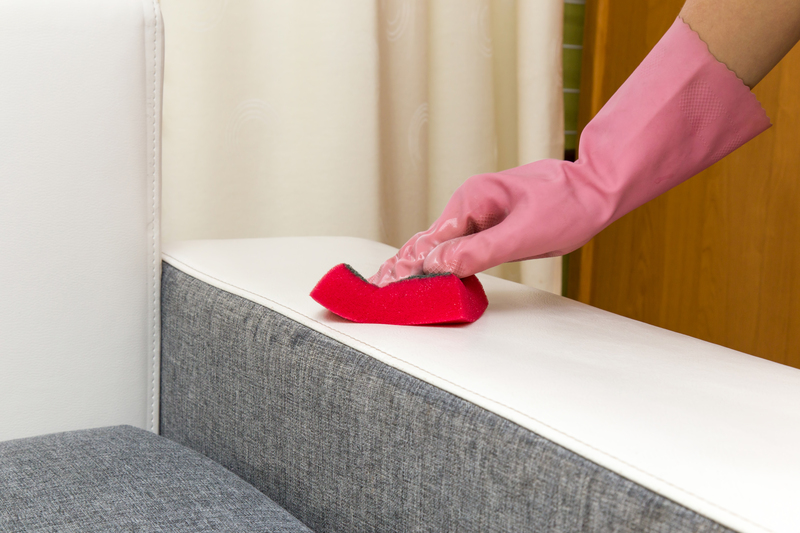Air Quality: A Key Factor in Indoor Comfort
Posted on 21/08/2025
Air Quality: A Key Factor in Indoor Comfort
When we think about creating a comfortable indoor environment, we often focus on factors like temperature, lighting, and furniture arrangement. However, a crucial and often overlooked aspect of comfort is air quality. Indoor air quality not only affects our sense of comfort but also has profound implications for our health and well-being.

Understanding Indoor Air Quality
Indoor air quality (IAQ) refers to the air purity and cleanliness within and around buildings, including homes, offices, schools, and other structures. Poor air quality indoors exposes inhabitants to a variety of pollutants, allergens, and contaminants. Good air quality is essential for a healthy and enjoyable lifestyle, making it a key element in ensuring comfort within indoor environments.
What Influences Indoor Air Quality?
- Ventilation: Adequate airflow helps dilute indoor pollutants and reduce contaminant concentrations.
- Sources of Pollution: Smoke, chemicals from cleaning agents, paint, building materials, pets, and mold contribute to poor air quality.
- Humidity Levels: High humidity promotes mold growth, while low humidity causes respiratory discomfort.
- Outdoor Air: Pollutants outside, such as vehicle emissions and pollen, can infiltrate indoor spaces.
All these factors combine to create either an optimal indoor climate or a problematic environment. Prioritizing air quality improvement inside homes and offices can dramatically boost comfort levels.
Why is Air Quality Vital for Indoor Comfort?
Studies show that the quality of the air we breathe indoors has a direct impact on various aspects of our lives. Here are some key reasons why air quality is a critical factor in indoor comfort:
- Health and Well-being: Poor air quality contributes to headaches, allergies, asthma, respiratory illnesses, fatigue, and even long-term health problems.
- Productivity and Concentration: Clean indoor air keeps us alert, productive, and able to think clearly. Stale or polluted air can cause drowsiness or reduced mental performance.
- Sleep Quality: Pollutants and irritants in the air disrupt sleep, making restful nights difficult, especially for allergy and asthma sufferers.
- Overall Comfort: The sensation of fresh, clean air greatly enhances perceived comfort, making living and working indoors more enjoyable.
Common Indoor Air Pollutants
To fully appreciate the importance of air quality in indoor comfort, it is helpful to recognize the most common sources of pollution found in homes and buildings:
- Volatile Organic Compounds (VOCs): Emitted from paints, varnishes, cleaning products, and furnishings, these chemical compounds can cause health issues.
- Particulate Matter (PM): Dust, pet dander, pollen, and particles from cooking or smoking can irritate lungs and contribute to allergies.
- Mold and Mildew: Damp conditions foster growth of these organisms, leading to poor air quality and possible respiratory problems.
- Carbon Monoxide (CO): This invisible, odorless gas from unvented appliances or engines is hazardous even in small concentrations.
- Radon Gas: Naturally occurring and potentially cancer-causing, radon can infiltrate homes from the ground below.
- Biological Contaminants: Bacteria, viruses, and pollen are additional contributors to indoor pollution.
Addressing these contaminants is integral to achieving healthy indoor air quality.
How Air Quality Affects Health and Comfort
Poor indoor air quality can cause immediate symptoms and long-term negative effects. Let's break down the different ways in which bad indoor air impacts our daily lives:
- Respiratory Issues: Chronic exposure to dust, mold spores, or pet dander can trigger allergies and asthma attacks.
- Irritation: Eyes, nose, and throat irritation are frequent reactions to polluted air indoors.
- Headaches and Fatigue: Contaminants in the air may lead to headaches, dizziness, and a consistent feeling of tiredness.
- Poor Concentration: Stale air decreases cognitive function and makes it harder to stay alert at work or school.
- Weakened Immune System: Prolonged exposure to pollutants can impair the body's natural defenses.
In contrast, clean air indoors helps maintain lung function, enhances the immune system, supports restful sleep, and fosters a sense of well-being. This is why improving indoor air quality is a cornerstone of indoor comfort.
Strategies to Improve Indoor Air Quality for Greater Comfort
Fortunately, there are many effective methods for enhancing air quality indoors. Here's a comprehensive look at the best strategies to maximize comfort through cleaner air:
1. Optimize Ventilation
- Open windows regularly to allow fresh air circulation and reduce pollutant buildup.
- Use exhaust fans in kitchens and bathrooms to remove moisture and contaminants.
- Install mechanical ventilation systems with air filters for advanced air exchange in modern, energy-efficient homes.
2. Control Source of Pollutants
- Choose low-VOC paints, adhesives, and furnishings to minimize chemical emissions.
- Store cleaning supplies and chemicals in tightly closed containers away from living areas.
- Immediately address water leaks to prevent mold growth and damp conditions.
3. Maintain Humidity Levels
- Keep indoor humidity between 30% and 50% to reduce dust mites, mold, and bacteria.
- Use dehumidifiers in damp areas and humidifiers during dry weather for optimal balance.
4. Regular Cleaning and Maintenance
- Dust and vacuum frequently using HEPA-filter vacuums to trap fine particles.
- Wash bedding, curtains, and rugs regularly to control allergens like dust mites and pet dander.
- Change HVAC system filters every 1-3 months, depending on use and household members.
5. Invest in Air Purifiers
- Consider portable HEPA air purifiers to filter out particles such as dust, pollen, and smoke.
- Select models with activated carbon to eliminate odors and chemical vapors.
6. Prevent and Eliminate Mold
- Fix leaks in roofs, walls, or plumbing to prevent mold-friendly moisture buildup.
- Clean visible mold using appropriate cleaning agents such as diluted bleach (while wearing protection).
- Increase ventilation in moisture-prone areas like bathrooms and basements.
7. Test for Radon and Carbon Monoxide
- Install carbon monoxide detectors on every floor, especially near sleeping areas.
- Test for radon gas, particularly in areas where elevated levels are common, and mitigate if necessary.
8. Incorporate Indoor Plants Wisely
- Some houseplants can help absorb toxins and enhance air oxygenation.
- However, too many plants or overwatering can increase humidity and promote mold.
The Role of Air Quality in Modern Building Design
With a growing awareness of the importance of indoor air quality, architects and interior designers now prioritize air quality in their projects. Some ways buildings are being constructed or retrofitted to promote superior indoor environments include:
- Dedicated Ventilation Systems: Mechanical and natural ventilation enhancements ensure fresh air even in sealed, energy-efficient structures.
- Non-toxic Building Materials: The use of low-emission paints, sealants, and flooring reduces indoor exposure to harmful chemicals.
- Smart Home Technology: Sensors and automated systems monitor air quality and adjust ventilation or filtration as needed.
- Green Roofs and Courtyards: Integrated vegetation and outdoor spaces provide more fresh air and filter airborne contaminants.
Certifications and Standards
- LEED: The Leadership in Energy and Environmental Design certification program evaluates and promotes sustainable building practices, including indoor air quality.
- WELL Building Standard: This standard places significant emphasis on indoor environment and occupant health, including advanced air quality measures.

Air Quality Technologies for Maximum Indoor Comfort
Technological innovation is making it easier than ever to monitor and improve air quality in residential and commercial buildings. Some advanced solutions include:
- Smart Air Quality Monitors: These devices continuously track particulates, CO2, VOCs, and humidity, alerting users to any problem areas instantly.
- Integrated HVAC Systems: Modern HVAC units can filter, humidify, dehumidify, and even purify the air automatically.
- Photocatalytic Purifiers: Using UV light and titanium dioxide, these purifiers destroy bacteria, viruses, and chemical contaminants.
- Electrostatic Precipitators: These air-cleaning technologies attract and trap fine particles, improving indoor conditions for allergy sufferers.
Choosing the Best Solution for Your Space
Selecting the right indoor air quality system depends on factors such as building type, local climate, and specific pollutants of concern. Consulting with HVAC and IAQ professionals can help ensure that your chosen solution maximizes indoor comfort and air quality.
Conclusion: Make Air Quality a Priority for True Indoor Comfort
Air quality remains one of the most crucial, yet often ignored, components of comfortable indoor environments. Whether at home, in school, or in the workplace, we all benefit from clean, breathable indoor air. By employing strategies such as source control, improved ventilation, humidity balancing, and advanced air purification, anyone can create an environment that supports both well-being and comfort.
Investing time and resources into enhancing indoor air quality will pay dividends in increased health, productivity, and daily happiness. Ultimately, achieving superior air quality is an investment in your well-being and in the comfort of those who share your indoor spaces.
Summary: The Key Points of Air Quality and Indoor Comfort
- Air quality is fundamental to health, productivity, and comfort indoors.
- Controlling pollutants and managing ventilation are essential strategies for improving IAQ.
- Modern technologies and building practices offer new ways to monitor and enhance indoor air.
- Prioritizing air quality creates healthier, more comfortable indoor environments for all.
Make air quality a top priority--your comfort, health, and peace of mind depend on it.




